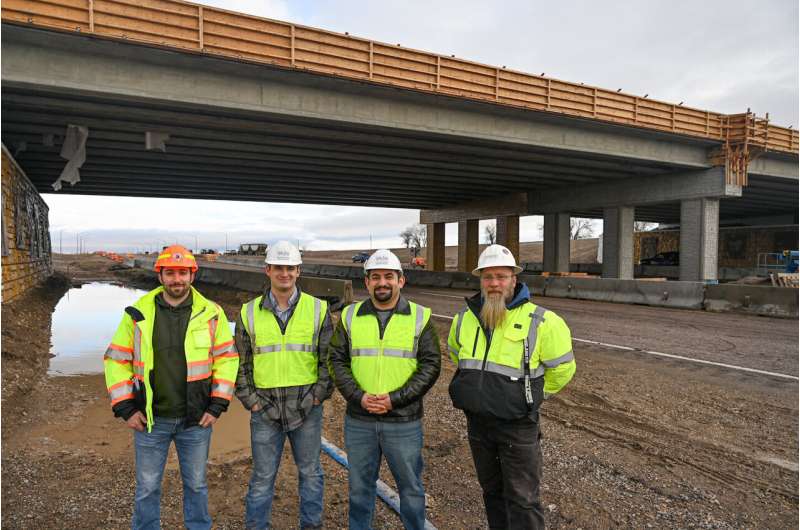
To the untrained eye it may not look like much, but you can see a piece of groundbreaking concrete on Interstate 15 at Exit 80 in Fort Hall thanks to the work of researchers at Idaho State University.
The new interchange features a precast concrete pier supporting the 222-foot long and 88-foot wide bridge spanning the Interstate. Unlike their cast-in-place counterparts, precast concrete components are cast off-site in controlled environments and transported to the construction site for final assembly. The pier is one of only a handful like it in the Gem State.
"A precast pier system incorporates structural elements such as columns and girders in a Lego-like construction," said Mustafa Mashal, associate professor of civil engineering at Idaho State and principal investigator on the project. "The connections between the elements are crucial for seismic resiliency. They must be strong enough to resist forces and deformations during an earthquake."
The initial concept for the piers was the brainchild of Leonard Ruminski, a former bridge designer with ITD who now works as a senior bridge engineer for Burgess & Niple. Collaborating with the researchers at Idaho State, he hypothesized that a concrete-filled steel pipe strategically placed in a critical location of the bridge inside the support would better dissipate the enormous stresses put on the piers during an earthquake.
"At that time, the only method being used in Idaho for connecting a precast column with the pier foundation and pier caps required very precisely placed and proprietary couplers," said Ruminski. "The precision needed to install the couplers was challenging and often resulted in construction delays. This new system uses only conventional materials and is much more straightforward to install, reducing amount of delays on a project."
Large-scale testing of the piers started in 2019 at ISU's Structural Laboratory (SLAB). In the SLAB, Mashal and his students tested the idea, building 11-foot tall and 15-foot wide models of the piers as well as models of the more common cast-in-place bridges.
"The large-scale lab tests we carried out for this project were, and may still be, the largest ever conducted in Idaho," said Mashal.
Using a hydraulic actuator, the team set out to see how much force each model could take and how the models deformed before breaking, and in the end, the precast pier came out on top. After a promising batch of tests, the precast pier was incorporated into the design for the I-15 Fort Hall Interchange project.
"Constructing a bridge is a lengthy process, and it can have significant impacts on traffic and the Fort Hall Interchange is a stretch of the I-15 corridor that can have significant traffic delays due to construction," said Michael Johnson, State Bridge Engineer with the Idaho Transportation Department.
"Typically, bridge piers take several months to construct and by using precast columns and bent cap beams, we were able to reduce this time to several weeks. In addition, most of the construction of the precast piers can be completed during lighter traffic hours, further reducing impacts on the traveling public and increasing safety for commuters and construction workers."
The research program at ISU was led by graduate students Corey Marshall, Ali Shokrgozar, Kathryn Hogarth, and Jared Cantrell, former graduate student and current research engineer at Idaho State. Results were recently published in a paper authored by Mahesh Acharya, doctoral candidate, Jose Duran, masters student, Arya Ebrahimpour, professor of civil engineering and co-principal investigator, Cantrell, and Mashal in the American Society of Civil Engineers' Journal of Bridge Engineering.
More information: Mahesh Acharya et al, A Fully Precast Pier System for Accelerated Bridge Construction in Seismic Regions, Journal of Bridge Engineering (2023). DOI: 10.1061/JBENF2.BEENG-6154
Citation: Precast pier system for accelerated bridge construction in seismic regions (2024, February 6) retrieved 6 February 2024 from https://techxplore.com/news/2024-02-precast-pier-bridge-seismic-regions.html
This document is subject to copyright. Apart from any fair dealing for the purpose of private study or research, no part may be reproduced without the written permission. The content is provided for information purposes only.
